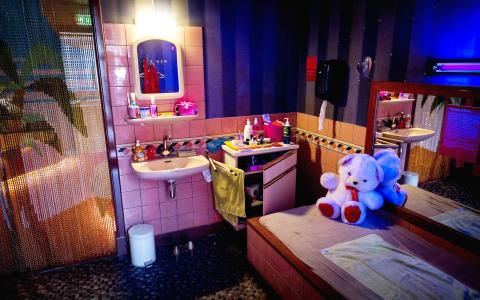Amsterdam’s red-light district opened its first “prostitution museum” on Thursday, hoping to lure tourists who always wondered what life was like for those on the other side of the infamous glass windows — but were too afraid to ask.
“How do they live? What happens in their world?” said Melcher de Wind, a founder of the Red Light Secrets Museum of Prostitution which showcases one of the Dutch capital’s most famous attractions.
“I have always wondered what really happens behind those neighborhood windows.”

Photo: EPA
Nestled between two famous brothels overlooking a canal, the new attraction seeks to offer something different to nearby museums on the subject such as the Sex Museum or the Museum of Eroticism.
“The other museums focus on sex and sexual performance. The new museum gives you a glimpse into the world of sex workers — what it feels like to stand behind a window and the looks you get,” explained Yolanda van Doeveren, who deals with prostitution for the Amsterdam municipality.
“Maybe tourists will get a chance to change their behavior and show a little more respect,” she added.
Inside the small museum, a large television screen shows a woman performing a strip-tease. Visitors are then shown a film about the other side of prostitution — women with families living everyday lives.
There are exhibits showing how both fashions and attitudes towards the world’s oldest profession have changed over the centuries.
Visitors are shown a display of the tools of the trade — condoms, lubricants and sex toys — based on the experiences of former prostitute Ilonka Stakelborough who advised the museum.
Prostitution in the Netherlands was legalized in 2000 and there are now around 7,000 people working in the industry in Amsterdam.
Around three-quarters of the women come from low-income countries, mainly from Eastern Europe, according to Amsterdam municipality figures.
They pay the equivalent of US$202 to hire one of Amsterdam’s 409 “frames,” which comes with a chair in front and a bed at the back.
Many women work 11 hours a day, six days a week with a visit to a prostitute lasting around 10 minutes.
The museum depicts BDSM (bondage, domination, sado-masochism) practices, and also features a “luxury” room with mirrored ceilings, a bed lit from below, and a bathtub next to an open bottle of champagne.
By way of contrast, there is a small room with barely space for a single bed that was used by a Polish prostitute when she was not with clients.
“We want to show all aspects of prostitution,” Stakelborough told AFP.
“Yes, there are women who are victims of human trafficking, but prostitution is mostly a career many women volunteer for.”

June 23 to June 29 After capturing the walled city of Hsinchu on June 22, 1895, the Japanese hoped to quickly push south and seize control of Taiwan’s entire west coast — but their advance was stalled for more than a month. Not only did local Hakka fighters continue to cause them headaches, resistance forces even attempted to retake the city three times. “We had planned to occupy Anping (Tainan) and Takao (Kaohsiung) as soon as possible, but ever since we took Hsinchu, nearby bandits proclaiming to be ‘righteous people’ (義民) have been destroying train tracks and electrical cables, and gathering in villages

Dr. Y. Tony Yang, Associate Dean of Health Policy and Population Science at George Washington University, argued last week in a piece for the Taipei Times about former president Ma Ying-jeou (馬英九) leading a student delegation to the People’s Republic of China (PRC) that, “The real question is not whether Ma’s visit helps or hurts Taiwan — it is why Taiwan lacks a sophisticated, multi-track approach to one of the most complex geopolitical relationships in the world” (“Ma’s Visit, DPP’s Blind Spot,” June 18, page 8). Yang contends that the Democratic Progressive Party (DPP) has a blind spot: “By treating any

Swooping low over the banks of a Nile River tributary, an aid flight run by retired American military officers released a stream of food-stuffed sacks over a town emptied by fighting in South Sudan, a country wracked by conflict. Last week’s air drop was the latest in a controversial development — private contracting firms led by former US intelligence officers and military veterans delivering aid to some of the world’s deadliest conflict zones, in operations organized with governments that are combatants in the conflicts. The moves are roiling the global aid community, which warns of a more militarized, politicized and profit-seeking trend

This year will go down in the history books. Taiwan faces enormous turmoil and uncertainty in the coming months. Which political parties are in a good position to handle big changes? All of the main parties are beset with challenges. Taking stock, this column examined the Taiwan People’s Party (TPP) (“Huang Kuo-chang’s choking the life out of the TPP,” May 28, page 12), the Democratic Progressive Party (DPP) (“Challenges amid choppy waters for the DPP,” June 14, page 12) and the Chinese Nationalist Party (KMT) (“KMT struggles to seize opportunities as ‘interesting times’ loom,” June 20, page 11). Times like these can